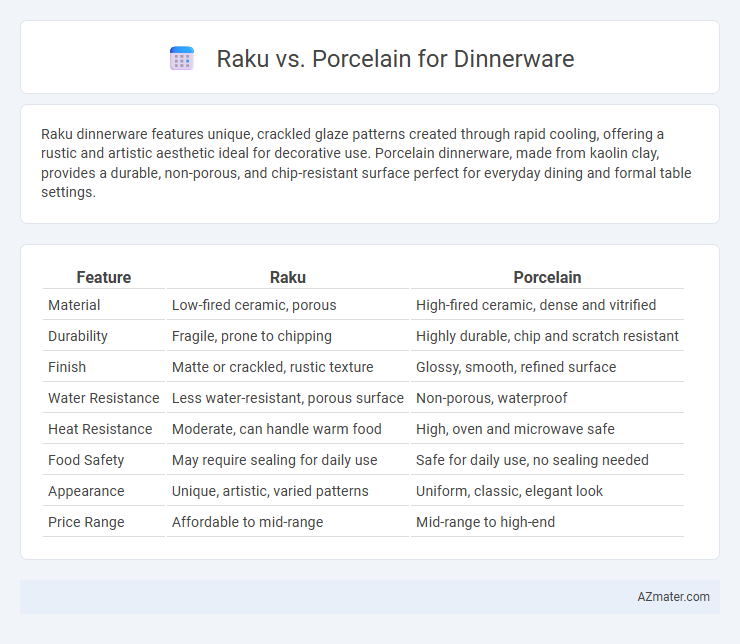Raku dinnerware features unique, crackled glaze patterns created through rapid cooling, offering a rustic and artistic aesthetic ideal for decorative use. Porcelain dinnerware, made from kaolin clay, provides a durable, non-porous, and chip-resistant surface perfect for everyday dining and formal table settings.
Table of Comparison
| Feature | Raku | Porcelain |
|---|---|---|
| Material | Low-fired ceramic, porous | High-fired ceramic, dense and vitrified |
| Durability | Fragile, prone to chipping | Highly durable, chip and scratch resistant |
| Finish | Matte or crackled, rustic texture | Glossy, smooth, refined surface |
| Water Resistance | Less water-resistant, porous surface | Non-porous, waterproof |
| Heat Resistance | Moderate, can handle warm food | High, oven and microwave safe |
| Food Safety | May require sealing for daily use | Safe for daily use, no sealing needed |
| Appearance | Unique, artistic, varied patterns | Uniform, classic, elegant look |
| Price Range | Affordable to mid-range | Mid-range to high-end |
Introduction to Raku and Porcelain Dinnerware
Raku dinnerware features a traditional Japanese firing technique that creates unique, crackled textures and organic, earthy tones, ideal for artisanal table settings. Porcelain dinnerware, made from refined clay and fired at high temperatures, offers a smooth, translucent finish with exceptional durability and resistance to chipping. Both materials serve distinct aesthetic and functional purposes, with Raku emphasizing handcrafted artistry and porcelain prioritizing elegance and strength in everyday use.
Historical Origins of Raku and Porcelain
Raku dinnerware traces its origins to 16th-century Japan, where it was developed for traditional tea ceremonies emphasizing simplicity and natural aesthetics. Porcelain, first crafted in 7th-century China during the Tang dynasty, is renowned for its white, translucent quality and durability achieved through high-temperature firing techniques. The distinct historical roots of Raku and porcelain reflect their cultural significance and influence on ceramic art worldwide.
Material Composition and Firing Techniques
Raku dinnerware is crafted from porous clay distinguished by its unique low-temperature firing process, which involves rapid cooling and smoke reduction to create crackled glaze effects. Porcelain is composed of refined kaolin clay and fired at high temperatures, resulting in a dense, non-porous, and translucent body renowned for its strength and durability. The contrasting firing techniques significantly influence their surface texture and thermal properties, with Raku offering artistic, unpredictable finishes and porcelain providing a smooth, uniform, and resilient finish suitable for daily use.
Aesthetic Differences: Colors, Textures, and Finishes
Raku dinnerware features unpredictable, smoky patterns with crackled glazes and a rustic, handmade appearance, highlighting organic textures and earthy tones that emphasize an artisanal aesthetic. Porcelain dinnerware offers a smooth, refined surface with consistent, glossy finishes and vibrant or delicate colors, often showcasing intricate designs or patterns that emphasize elegance and precision. The tactile experience between the two varies significantly, with raku providing a rough, textured feel contrasted by porcelain's sleek and polished smoothness.
Durability and Longevity Comparison
Raku dinnerware, known for its artistic glazing and thermal shock resistance, often exhibits fragility due to its porous nature and low firing temperatures, making it less durable for everyday use compared to porcelain. Porcelain dinnerware is fired at higher temperatures, resulting in a dense, non-porous material that offers superior resistance to chipping, cracking, and wear, significantly enhancing its longevity. The inherent strength and vitrification in porcelain make it ideal for long-term use and frequent handling, whereas raku pieces are better suited for decorative purposes or occasional dining.
Suitability for Everyday Use
Raku dinnerware, characterized by its unique crackled glaze and porous surface, is generally less durable and more prone to chipping, making it less suitable for everyday use. Porcelain dinnerware offers a non-porous, highly durable surface that resists staining and withstands frequent dishwasher and microwave usage. For practical daily dining, porcelain provides superior longevity, ease of maintenance, and consistent performance compared to Raku ceramics.
Maintenance and Care Requirements
Raku dinnerware requires delicate handling and avoidance of dishwasher use due to its porous nature and vulnerability to thermal shock, necessitating hand washing with mild detergent and gentle drying methods. Porcelain dinnerware offers superior durability and is typically dishwasher and microwave safe, making it easier to maintain with regular cleaning practices and minimal risk of chipping or cracking. Proper care for Raku involves protecting its glaze from harsh chemicals and soaking, whereas porcelain's non-porous surface resists stains and odors, enhancing long-term usability.
Environmental Impact and Sustainability
Raku dinnerware involves a low-temperature firing process that consumes less energy but often results in irregular durability, leading to potential waste and replacement frequency concerns. Porcelain, fired at higher temperatures, offers enhanced longevity and resistance to wear, reducing the need for frequent replacements and minimizing environmental impact over time. Sustainable dinnerware choices prioritize durability, energy-efficient production, and non-toxic materials, with porcelain typically outperforming raku in long-term eco-friendliness.
Price Range and Accessibility
Raku dinnerware typically falls into a mid to high price range due to its handmade nature and unique firing process, making it less accessible for everyday use. Porcelain dinnerware offers a broader price range, from affordable mass-produced sets to high-end artisan pieces, enhancing its accessibility for various budgets. Availability of porcelain in many retail outlets and online stores makes it easier to purchase compared to the more specialized market for Raku pottery.
Choosing the Best Dinnerware: Raku or Porcelain?
Raku dinnerware offers a unique, handcrafted aesthetic with irregular textures and metallic glazes, ideal for rustic or artistic table settings, while porcelain boasts durability, smoothness, and a classic, elegant appearance suitable for everyday use and formal occasions. Porcelain's non-porous surface makes it highly resistant to stains and chipping, ensuring long-lasting functionality, whereas Raku's porous nature requires careful handling and is best for decorative purposes or occasional use. Selecting the best dinnerware depends on your preference for durability and elegance with porcelain or artistic expression and artisanal appeal with Raku.

Infographic: Raku vs Porcelain for Dinnerware
 azmater.com
azmater.com